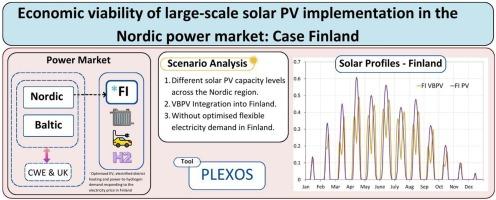北欧电力市场大规模太阳能光伏实施的经济可行性:芬兰案例
IF 5.9
Q2 ENERGY & FUELS
引用次数: 0
摘要
本研究以芬兰为例,分析了到2030年北欧地区公用事业规模太阳能光伏的快速增长将如何影响其经济可行性。该分析基于对北欧电力市场的建模。太阳能对北欧地区的能源转型至关重要;然而,高渗透率带来了重大的经济挑战。芬兰缺乏太阳能光伏发电的上网电价补贴,能源系统的灵活性有限,核能和风能的高份额以及雄心勃勃的太阳能扩张计划使芬兰成为一个热门案例。本研究利用PLEXOS先进的电力市场模拟工具,详细模拟北欧和波罗的海多国电力系统及其与中东欧电力市场的连接。该研究包括电动汽车、区域供热电气化和氢气生产的快速增长带来的重大电力需求变化。到2030年,对北欧地区不同太阳能光伏水平的多个场景进行了分析,其中包括垂直安装、东西面向的双面太阳能光伏的不同份额。结果表明,北欧地区的大规模太阳能光伏发电整合可能会使芬兰的电价暴跌,特别是在夏季。到2030年,这一扩张将使太阳能捕获率降低到40%,突显芬兰的太阳能蚕食。这些发现表明了广泛部署太阳能光伏的潜在经济风险和市场适应的必要性。整合垂直双面板来调整光伏生产剖面和优化电动汽车充电对于提高太阳能发电的经济可行性非常重要。本文章由计算机程序翻译,如有差异,请以英文原文为准。

Economic viability of large-scale solar PV implementation in the Nordic power market: Case Finland
This study analyses how the rapid growth of utility-scale solar PV in the Nordic region will impact its economic viability by 2030, using Finland as a case study. The analysis is based on modelling the Nordic electricity market. Solar energy is crucial for the energy transition in the Nordic region; however, high penetration levels pose significant economic challenges. The lack of feed-in tariffs for solar PV, limited energy system flexibility, high shares of nuclear and wind power and ambitious solar expansion plans make Finland a topical case study. Using PLEXOS advanced electricity market simulation tool, this study models the Nordic and Baltic multinational electricity system in detail and its connections to the Central Western European power market. The study includes significant electricity demand changes from rapid increases in electric vehicles, district heating electrification, and hydrogen production. Multiple scenarios representing different solar PV levels across the Nordic regions are analysed by 2030, including one scenario with various shares of vertically mounted, east-west-oriented bifacial solar PV. Results indicate that large-scale solar PV integration in the Nordic region could collapse Finnish electricity prices, specifically in the summer months. This expansion would reduce solar capture rates to 40% by 2030, highlighting the solar cannibalisation in Finland. These findings indicate the potential economic risks of extensive solar PV deployment and the need for market adaptation. Integrating vertical bifacial panels to adjust the PV production profile and optimising the electric vehicle charging are found to be important to improve the economic viability of solar generation.
求助全文
通过发布文献求助,成功后即可免费获取论文全文。
去求助
来源期刊

Renewable Energy Focus
Renewable Energy, Sustainability and the Environment
CiteScore
7.10
自引率
8.30%
发文量
0
审稿时长
48 days
 求助内容:
求助内容: 应助结果提醒方式:
应助结果提醒方式:


